Stay afloat during the pandemic: 5 useful tips
May 6, 2020

As the coronavirus disease continues to spread all over the world, more and more businesses are faced with a difficult decision: find a way to adapt to the current situation or close their doors forever. Here are some tips to help your business adjust to the challenges of the pandemic and stay afloat during these tough times.
Reduce expenses
This one is obvious but still bears mentioning: take out your books and find out where and how you can cut costs without affecting the quality of your service.
Putting off non-essential or discretionary expenses, such as repainting your offices or buying new equipment, is a no-brainer. Cutting out fixed expenses such as rent and loan payments is harder, if not impossible, to do. However, it is crucial if your production and revenue are at a standstill.
Try asking your landlord for a reduction or deferment of a portion of your rent. Also, ask your bank if you can put off or skip loan payments for a finite period, or if they can at least waive fees on late or missed payments. (Find out if your bank is one of those offering relief to borrowers amid the pandemic here.)
Learn from your competitors
Observe both your direct and indirect competitors, especially those that are faring better than others. Find out what they’re doing differently and see if this will work for your business. More than adopting these strategies, it’s important to adapt them to your own and your customers’ needs.
It’s also a good idea to look at larger organizations within your industry. SMBs like yours may not be able to compete with bigger players on a scale level, but you can learn a few things about customer service, marketing strategies, and the like from them.
Redefine your business model
Even with coronavirus restrictions gradually being lifted across the United States, it would take a while before things return to normal. It’s crucial to ask yourself if traditional business models would still make sense in a post-COVID-19 world and adjust accordingly.
Determine any changes you need to make to your current business model. This involves identifying who your customers are and what they need, your staff’s capabilities, and any uncertainties and their impacts. Such changes may include finding a way to deliver your products or services to your customers, just like what groceries and restaurants did in the face of lockdowns and shelter-in-place directives.
Connect with your customers
Understand that many of your customers may have been affected in some way by the pandemic — they might have been laid off, for instance, or are caring for a family member who tested positive for COVID-19. They may reach out to you to pause or cancel your services, or to ask for a discount or payment deferral. When speaking to them, demonstrate empathy, whatever their concerns may be. When things get back to normal, it’s likely that those who had a positive experience with you during the pandemic will stick around and keep doing business with you.
Keeping your customers informed throughout these trying times is important. Make sure, though, that what you’re saying is relevant to them. For example, if you run an eCommerce business, let your customers know through email or social media about any shortages in supply and when you expect to be able to fulfill their orders. Doing so reassures customers that you’re doing your best to provide them with the same quality of service pre-COVID-19.
Upskill your staff
Upskilling your employees may be the best way to spend your resources during the current situation. Equipping your team with new knowledge and skills will help them adapt to the changing business environment.
Sharpening your team’s digital skills is especially important now that the COVID-19 crisis is spurring digital transformation. Other areas to focus on are project management, communication, data analytics, and digital marketing. And if you find yourself short-staffed, it might pay to train employees to handle other aspects of your business, ensuring that everything runs smoothly throughout the pandemic and beyond.
The current situation requires swift and decisive action from business leaders. Making smart and proactive decisions now will ensure that you’ll mitigate the impacts of COVID-19 on your business, and that you’ll emerge from this crisis stronger than ever. For more tips on how to run your business effectively in times of crisis, drop our experts a line today.
Published with permission from TechAdvisory.org. Source.

A slow computer or a frozen screen are the worst things that can ruin your day. You've most likely dealt with outdated technology on multiple occasions if you manage a small business. It may seem cost-effective to extend the life of outdated equipment, but the long-term costs are frequently higher. Due to technological issues like sluggish PCs and antiquated laptops, small businesses lose about 98 hours annually, or 12 working days . This is why it's important to have an IT refresh plan. It helps you stay safe, prevents unplanned malfunctions, and keeps your team operating efficiently. Regardless of whether you outsource managed IT services or handle them in-house, a solid refresh strategy can save time, stress, and money down the line.

Does your small business ever feel like it has too much data? This is a fairly typical occurrence. The way small businesses function has changed as a result of the digital world. In addition to customer emails and backups, we now have an overwhelming amount of data to manage, including financial statements, contracts, logs, and employee records. According to a PR Newswire survey, 72% of company executives say they have stopped making decisions because the information is too overwhelming. All of this data can easily become disorganized if improperly handled. By implementing the appropriate data retention policy, effective IT solutions assist. A strong data retention policy keeps your company compliant, organized, and cost-effective. Here's what should be deleted, what should be kept, and why.

Selecting the best cloud storage solution can be similar to being faced with an endless buffet of options, each one claiming to be the best. A poor choice may result in lost revenue, compromised data, or even a snag in productivity. The stakes are extremely high for small business owners. Regardless of your level of experience, we will guide you through this thorough guide to help you choose a cloud storage solution that is specific to your company's needs.

Cyber threats are a daily reality for small businesses navigating an increasingly digital world; they are not merely an abstract concern. Financial and reputational harm can result from ransomware attacks, phishing scams, or unintentional data leaks. In order to reduce the risks, more businesses are using cyber insurance. Not every cyber insurance plan is made equally. Many business owners think their policy covers them, but they discover (too late) that it has significant gaps. We'll explain exactly what is and isn't covered in this blog post, along with how to pick the best cyber insurance plan for your company.

Have you ever questioned how susceptible your company is to online attacks? Nearly 43% of cyberattacks target small businesses , frequently taking advantage of lax security measures, according to recent reports. Multi-Factor Authentication (MFA) is one of the most underutilized yet powerful ways to safeguard your business. Even with your password, hackers will find it much more difficult to obtain access thanks to this additional security measure. The implementation of Multi-Factor Authentication for your small business is explained in this article. Knowing this will enable you to take an important step toward protecting your data and guaranteeing more robust defense against possible cyberattacks.

Managing a small business requires a lot of multitasking. These hats include operations management, customer service, and maintaining order. AI-powered automation is a solution that can reduce the workload. Small business owners can now automate tasks that were previously done by hand thanks to technological advancements that have made these tools more affordable and accessible than before. There's no need to hire a big staff or spend a fortune. AI can manage a large portion of your hectic workload, allowing you to concentrate on more crucial facets of your company. AI can act as your virtual assistant, increasing productivity and simplifying processes, whether you're a small team manager or a solopreneur. This blog post explores how you can automate everyday tasks and free up your time if you want to learn more about how AI can change your company. We'll demonstrate how to use reasonably priced AI tools to reduce repetitive tasks, save time, and increase business efficiency.

In today's digital world, cyber threats are smarter than ever. Weak passwords or old ways of proving who you are can cost people and businesses money, steal their data, or steal their identities. A strong password is the first thing that will keep hackers out, but it's not the only thing that will work. This guide goes over the basics of strong passwords, two-factor authentication, and the best ways to keep your accounts safe. We'll also talk about new ways to check things and things you should never do.

A sophisticated type of cyberattack known as "password spraying" uses weak passwords to acquire unauthorized access to numerous user accounts. This approach focuses on using a single password or a collection of passwords that are frequently used across multiple accounts. The goal is to circumvent standard security protocols, such as account lockouts. Password-heavy attacks are highly effective because they target people and their password management practices, which are the biggest weakness in cybersecurity. This ar ticle will describe how password spraying operates, address how it differs from other brute-force attacks, and go over how to detect and prevent it. We will also discuss how businesses can defend themselves against these threats and examine real-world examples.

What would happen if tomorrow your company lost all its data? Would your operations come to a complete stop, or would you be able to recover? Data, including communications, financial records, product files, and customer information—is the lifeblood of any small business. However, data security is frequently neglected. After a disaster, 25% of small businesses close within a year, and 40% never reopen , according to the Federal Emergency Management Agency (FEMA). That represents an incredible 65% failure rate because of inadequate preparation. The good news is here. An enterprise budget and a dedicated IT staff are not necessary for disaster data protection. You can create a backup and recovery plan that reduces downtime and provides you with peace of mind if you have the right approach, the appropriate tools, and a little forethought. In this blog post, we will discuss practical and easy-to-follow advice to help you protect your most valuable business asset: your data.

